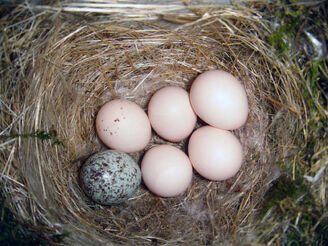
A eastern Phoebe nest with a Brown Cow Bird egg in it.
Certain birds, known as brood parasites, lay their eggs in the nests of other birds and do not provide any parental care for their own offspring. There are two types of brood parasitism, non-obligate and obligate. Non-obligate brood parasites lay eggs in the nest of conspecifics which is the same species. An example of this type would be the Bank Swallow.
Brown Cow Bird[]
The most well known of an obligate brood species would be the Brown Cow bird. In fact, the genus name of cowbirds, Molothrus, means "intruder" in Latin (Davies, 2000).
Pros and Cons of Brood parasitism[]
For the parasite, benefits include increased fecundity due to greater allocation of resources toward mating and producing more eggs rather than defending nests, incubating eggs, and feeding young. For hosts of brood parasitic birds, the costs of parasitism range from diminished nestling growth rate, due to competition with larger and more competitive parasitic offspring (cowbirds, whydahs), to total loss of breeding by the abandonment of parasitized broods (cowbirds, cuckoos), the eviction of all host eggs by the early-hatching parasites (cuckoos), or the killing of host hatchlings by parasitic hatchlings (cuckoos, honey guides) (Kilner 2005; Servedio & Hauber 2006).
Kilner, R. The evolution of virulence in brood parasites. Ornithological Science 4, 55–64 (2005).
Davies, N. B. Cuckoos, Cowbirds and other Cheats. London, UK: T. & A. D. Poyser, 2000.